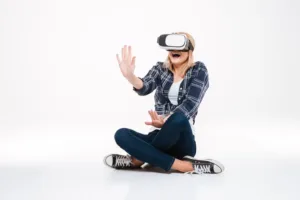Some years ago, marketing professionals introduced the concept of market segmentation. This notion rejected the traditional belief that a product or service had only one life to live in the marketplace. Instead, the same product could be marketed to diverse audiences. A product could also be redesigned or modified so that each permutation appealed to a different type of customer.

So, as we identify and appeal to distinct groups of customers, we stand to increase the sales count, penetration, and effectiveness of our technology products.
A recent conversation held in an ISTE (the International Society for Technology in Education) online discussion forum for teachers touched upon such a market segmentation opportunity. Teachers were asking “What VR headgear made the most sense for the K-12 classroom”?
Although folks had their obvious favorites, what also emerged from the discussion was a clearer sense of what educators really need in the classroom as far VR headgear, something approaching education-centric specifications for HMD in the classroom, if you will. With these “market segmentation” ideas firmly in mind, greater opportunities for HMD and virtual reality are possible, at least in the ed market. I decided to cover these expectations here, because our readers no doubt have increasing occasion to interact with educators, aim products at the education market, bid on tenders, and attempt to sell VR to scale in schools.
Whether a school is looking for a few individual VR headgear for a learning center, a class set of gear for teachers to borrow and share, or multiple classroom sets for broader deployment in the school, educators are starting to desire or demand specific features or attributes. Of course, most of their product requirements are specific to the non-tethered type VR headset, but not all. It’s just that all-in-one or smartphone based VR displays currently dominate the educational landscape.
So let’s get to it. What do educators really want to see in virtual reality headsets? Below are their clear priorities, with my commentary in parentheses. Do you see any surprises? Classroom-based headsets must
- be inexpensive (always the most common criteria, of not the most important, to a clear majority of educators)
- offer a head strap for hands-free control (ensuring a lot less dropping of devices and ease of use)
- offer an external ‘button’ control (interaction trumps passive viewing)
- provide adjustable stereo lenses (interocular distances vary greatly as children grow older)
- guarantee ‘headroom’ for audio/headphones (think noisy classrooms)
- accommodate varying sizes of phones
- be sturdy (able to take a beating and last the entire school year or longer)
- enable facile cleaning/disinfecting after use (Some commenters were worried about spongy materials hindering the disinfecting of headgear between uses, but I suspect that won’t matter as much. The medical community I work closely with on this issue suggests three possible avenues for manageable classroom disinfecting: use antibacterial or alcohol swipes, or a UV cabinet.)
- be easily storeable (think about a supportive storage ecosystem or foldable/collapsible headgear; the less room your initiative takes up, the better, in crowded classroom spaces)
Another interesting idea, but not one of the priorities above, was headgear that enabled either/or viewing of VR and AR, enabling the student to use the same goggle for hands-free AR as well as VR, such as the Merge headgear. Two birds with one stone, if you will.
These education sector ‘requirements’ are instructive, representing “know-your-customer” specifications. And in all likelihood, these same specs are equally applicable to AR displays as well. – Len Scrogan

